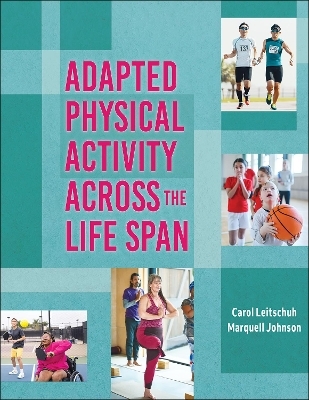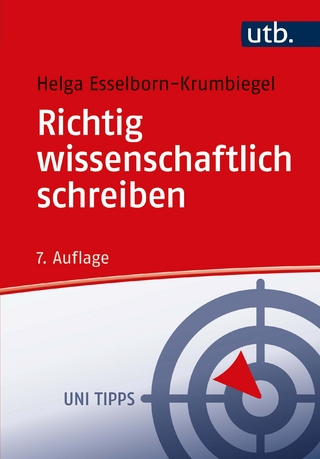
Adapted Physical Activity Across the Life Span
Human Kinetics (Verlag)
978-1-7182-1336-4 (ISBN)
- Titel z.Zt. nicht lieferbar
- Versandkostenfrei innerhalb Deutschlands
- Auch auf Rechnung
- Verfügbarkeit in der Filiale vor Ort prüfen
- Artikel merken
While there are plenty of texts out there on adapted physical activity, there are none like this one.
That’s because Adapted Physical Activity Across the Life Span takes a unique interdisciplinary approach from education, sports, and the health sciences. It incorporates adapted physical activity’s long history of DEI (diversity, equity, and inclusion) and the importance of SEL (social-emotional learning) to prepare pre-professionals and professionals for service delivery in today’s world.
Adapted Physical Activity Across the Life Span features the following:
An interdisciplinary and life span approach to show students the broad scope of careers across education, clinical, and community settings
Interviews with professionals that provide students with real-life stories from educators, allied health care professionals, coaches, and others who work with people with disabilities
Information about adapted physical activity for early childhood, with a focus on professions that help a young child with a disability begin their journey of adapted physical education
Content on adapted physical education for children and young people to educate students in the full implementation of IDEA and general physical education for children with disabilities, including interdisciplinary assessments, IEPs, and program modifications
Content on adapted physical activity for adults to enable students to understand the roles of various professions that facilitate adapted physical activity for adults—from those who recently finished high school to senior citizens—using the Healthy People guidelines, research, best practices, and the most contemporary model of aging
Chapter objectives, chapter summaries, tables, and charts that emphasize key concepts
Instructor ancillaries to make it easier for instructors to prepare for and teach the course
The interdisciplinary approach provides instructors greater flexibility for courses that include students not only from adapted physical education and general physical education but also from allied health professions: occupational therapy, physical therapy, speech and language pathology, nursing, medicine, sport psychology, exercise physiology, therapeutic recreation, and more.
“Today, the interdisciplinary nature of service in adapted physical activity begins in the earliest ages and continues with professionals who instruct and nurture the physical activity of the oldest of our communities,” says coauthor Carol Leitschuh. “This is the life span approach.”
Coauthor Marquell Johnson adds, “The interdisciplinary approach and life span approach provide a much wider view of helping people with disabilities achieve optimal health. Most texts focus on a narrower perspective, such as in school, in a medical or community setting, or with a certain age group. However, this book looks at all the professions that are involved in a person’s life throughout the life span and offers a coordinated approach.”
Adapted Physical Activity Across the Life Span will help prepare future professionals to serve individuals who require adaptations to be able to enjoy full and healthy active lives over their lifetimes. From infants to the elderly, all across the life span, people can be physically active—and this text will help them be just that.
Carol Leitschuh, PhD, is a consultant. She is a former faculty member of the University of Minnesota (UMN) School of Kinesiology, where she taught in the doctoral, master’s, and bachelor’s degree programs. She was also coordinator of the UMN master's program in developmental and adapted physical education, affiliated with the Center for Early Education and Development (CEED) and Center for Neurobehavioral Development (CNBD). Dr. Leitschuh received an Initial Career Award from the Office of Special Education Programs. She developed a tool that monitored the early movement skills of infants and toddlers. Twice she was a visiting scholar of the Erasmus Mundus Program in Adapted Physical Activity. As a Fulbright Scholar in child development, she was a lecturer in the Czech Republic. She received her PhD in human performance, focusing on movement studies in disability. She was awarded a postdoctoral research fellowship at Juniper Gardens Children’s Program at the University of Kansas. Marquell Johnson, PhD, is a professor at the University of Wisconsin–Eau Claire (UWEC) and is the director of rehabilitation science and the director of the physical activity and recreation for individuals with disabilities in the university’s P.R.I.D.E. and P.R.I.D.E.4Adults outreach programs. He received his PhD in nutrition and exercise science, focusing on movement studies in disability. He has received the Dr. Ron Satz Teacher/Scholar Award (2017); an Excellence in Mentoring in Research, Scholarship, and Creative Activity Award (2016); the UWEC Excellence in Service-Learning as a Faculty Mentor Award (2014); and numerous other awards. His teaching focuses on adapted physical activity and motor development, rehabilitation science, research methods, research and creative activities, physical activity and health behaviors of individuals with disabilities, and related areas.
Part I. Overview and Scope
Chapter 1. Physical Activity and Disability
History of Professional Disability Service
Understanding Disability
Life Course Perspective
Summary
Chapter 2. Professional Roles in Adapted Physical Activity
Professional Disciplines
Professionals in the Schools
Professionals in the Community
Professionals in Health Care
Summary
Chapter 3. Disability and the Law
Individuals with Disabilities Education Improvement Act of 2004
Americans with Disabilities Act Amendments Act of 2008
Every Student Succeeds Act of 2015
Individualized Education Program
Individualized Family Service Plan
Summary
Chapter 4. Designing Life Span Programs
Physical Activity Program Goals
Infants and Toddlers
Preschoolers
Kindergarteners
Elementary School Ages
Middle to High School Ages
Adults
Summary
Part II. Adapted Physical Activity in Schools
Chapter 5. Instructional Strategies
Ecological Theory
Developmental Systems Theory
Life Course Health Development
Universal Design for Learning
Motivation and Disability
Instructional Style
Instructional Techniques
Summary
Chapter 6. Assessment and Evaluation
Assessment Process
Evaluation Process
Legal Assessment Requirements
Approaches to Assessment
Screening Test Selection
Norm-Referenced Assessments
Nonstandardized Assessments
Evaluation Communication
Summary
Chapter 7. Intellectual Disability
Causes and Prevalence
Classification and Diagnosis
Instructional Considerations
Program Placement and Focus
Instructional Strategies
Physical Activities
Serving Students With Severe or Profound ID
Educational Health Care Providers
Summary
Chapter 8. Autism Spectrum Disorder
Causes and Prevalence
Classification and Diagnosis
Instructional Considerations
Program Placement and Focus
Instructional Strategies
Physical Activities
Assessment and Evaluation
Summary
Chapter 9. Specific Learning Disabilities and Attention-Deficit/Hyperactivity Disorder
Causes and Prevalence
Classification and Diagnosis
Instructional Considerations
Program Placement and Focus
Instructional Strategies
Physical Activities for Children With ADHD
Assessment and Evaluation for Children With SLD
Educational Health Care Providers
Summary
Chapter 10. Behavior Disorders
Causes and Prevalence
Classification and Diagnosis
Instructional Considerations
Program Placement
Instructional Strategies
Physical Activities
Assessment and Evaluation
Educational Health Care Providers
Summary
Chapter 11. Sensory Impairments
Causes and Prevalence
Classification and Diagnosis
Instructional Considerations
Program Placement and Focus
Instructional Strategies
Physical Activities
Assessment and Evaluation
Educational Health Care Providers
Summary
Chapter 12. Orthopedic Impairment and Traumatic Brain Injury
Causes and Prevalence
Classification and Diagnosis
Instructional Considerations
Program Placement and Focus
Instructional Strategies
Physical Activities
Assessment and Evaluation
Educational Health Care Providers
Summary
Chapter 13. Other Health Impairment
Obesity
Diabetes Mellitus
Asthma
Epilepsy
Human Immunodeficiency Virus
Sickle Cell Anemia
Hemophilia
Temporary Conditions of Disability
Summary
Part III. Adult Adapted Physical Activity
Chapter 14. Health-Related Fitness
Components of Health-Related Fitness
Exercise Intensity
Exercise Recommendations
Health and Disability
Exercise Initiation
Considerations for Selected Conditions
Summary
Chapter 15. Leisure Activity
Community and Professional Resources
Leisure Activity Checklist
Aging and Disability
Leisure Activity Recommendations
Summary
Chapter 16. Adapted Sport
Experience and Training
Adapted Sport in Adulthood
Professional Support
Classifications for Adapted Sport
Individual Sports
Dual Sports
Team Sports
Summary
| Erscheinungsdatum | 28.10.2023 |
|---|---|
| Verlagsort | Champaign, IL |
| Sprache | englisch |
| Maße | 216 x 279 mm |
| Gewicht | 975 g |
| Themenwelt | Sozialwissenschaften ► Pädagogik |
| Weitere Fachgebiete ► Sportwissenschaft | |
| ISBN-10 | 1-7182-1336-0 / 1718213360 |
| ISBN-13 | 978-1-7182-1336-4 / 9781718213364 |
| Zustand | Neuware |
| Haben Sie eine Frage zum Produkt? |
aus dem Bereich


